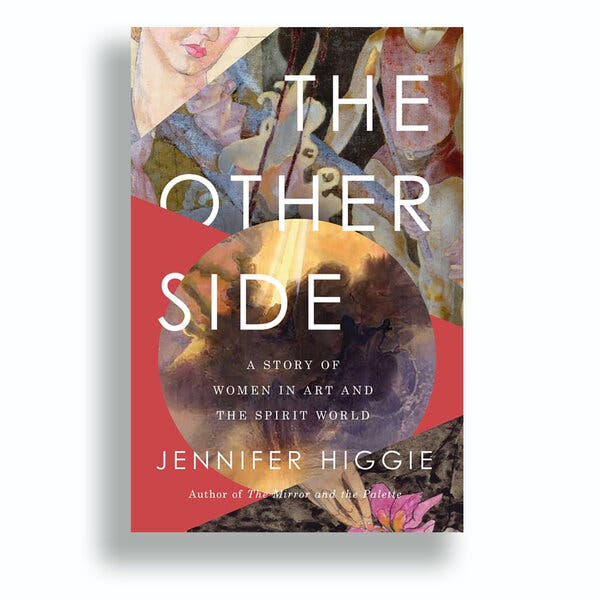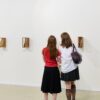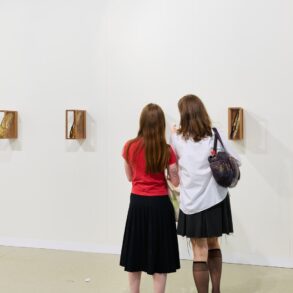THE OTHER SIDE: A Story of Women in Art and the Spirit World, by Jennifer Higgie
Anyone who has created a work of art knows how it feels to travel to another realm, to leave the world behind and enter a place apart. The artist exists there, poised and sometimes barely breathing, in a state of heightened awareness that is as thrilling as it is excruciating.
Thrilling because, if the piece works, the artist will have given birth to something that has never before existed. Excruciating because of that pesky word, “if.” That is what drives artists mad — along with their solitude as they strive to corral what they cannot see and often don’t understand.

The artist and teacher Hans Hofmann identified that quest as the search for the artist’s very “nature,” which, he said, is always art’s true subject. “How can one paint anything else?” While Hofmann’s conclusion might be a given for men, it has not been for many women artists. Ignored, discouraged and at times even forbidden from painting, women throughout history who craved artistic expression were often forced to sublimate their powerful nature into something deemed less dangerous: the spirit world. That is one of the subjects the Australian critic Jennifer Higgie ponders in her intriguing book, “The Other Side.”
The author of “The Mirror and the Palette,” a nuanced and idiosyncratic take on female self-portraiture, Higgie explores her subjects through a series of miniature biographies. One she includes here is that of Georgiana Houghton. The 19th-century British painter created abstract works so advanced that she was forced to exhibit them herself with the proviso: “To those who do not understand the subject, it may be needful to explain that in the execution of the Drawings, she has been entirely guided by invisible spirits.”
Consider Houghton’s contemporary Anna Mary Howitt, whose career as a celebrated artist and illustrator came to a crashing halt in 1856 when she dared to paint the ancient queen Boadicea avenging the rape of her daughters. Accused of being an “angry woman” by one critic and told to “leave such subjects alone” by the powerful John Ruskin, she destroyed her work and began drawing images she claimed to receive from spirits on “the other side.”
Art and literature are filled with women who have circumvented patriarchal obstacles by claiming to be mere conduits for messages from the beyond. (Harriet Beecher Stowe said she was merely taking dictation from God when she wrote her seminal abolitionist novel, “Uncle Tom’s Cabin.”)
Houghton and Howitt may have been engaged in just that type of subterfuge when, in order not to be seen as expressing themselves directly, they pointed to the unseen as the source of their inspiration. Or, perhaps, they truly did believe that their minds and hands were guided by forces outside themselves. Higgie respectfully entertains the possibility that the spirits these artists channeled were real — as real as the religious beliefs that have inspired male artists for centuries.
Higgie grounds her meditation in history by introducing readers to artists, both female and male, who, in their search for meaning, wandered into spiritualism, mysticism or even the fanciful land of fairies. Those artistic forays almost always coincided with periods of dramatic social, industrial or technological change, when the old answers no longer sufficed and the future was uncertain.
Take, the years between 1840 and 1870, which the author identifies as the golden era of fairy painting. . Those decades saw the publication of Charles Darwin’s “On the Origin of Species” and Karl Marx’s “Communist Manifesto”; European uprisings of people against their rulers; a civil war in the United States; the official end of American slavery and Russian serfdom; and the rise of a women’s rights movement in the U.S. and Britain.
Male painters who retreated into fairyland when all that reality became too much (among them the utterly mad Richard Dadd) are still collected and admired. Their female contemporaries, notably the once widely exhibited Amy Sawyer, are all but forgotten. And so it continued into the 20th century.
Female artists who communed with the spirits were generally dismissed as kooks (think Hilma af Klint), while their male counterparts (in af Klint’s case, Wassily Kandinsky) were heralded as geniuses.
The strength of Higgie’s book, however, is that it is not merely another treatise on the wrongs suffered by women artists throughout history. This tale is about something much larger than grievance. There is a vein of optimism and wonder running through the text. The women whom Higgie profiles created, and they did so despite cultural scorn.
The spiritual movements that inspired generations of artists were in large part the offspring of women like Madame Helena Petrovna Blavatsky and Annie Besant. If these powerful figures felt rejected by the physical world, perhaps they found shelter in the metaphysical, among like-minded renegades.
Throughout the book, the author describes her own artistic journey as a painter and a writer. It is a bold decision to position oneself alongside women of such historical importance and I’m not convinced it always works. But that might be my bias as a writer who likes to remain outside a story.
No doubt Higgie’s exploits will resonate with many readers as she personalizes the female artist’s continued struggle to find a home in the art world — and shows that the other world, which exists beyond our consciousness at the point of creation, is welcoming still.
THE OTHER SIDE: A Story of Women in Art and the Spirit World | By Jennifer Higgie | Pegasus | 312 pp. | $29.95
This post was originally published on this site be sure to check out more of their content







